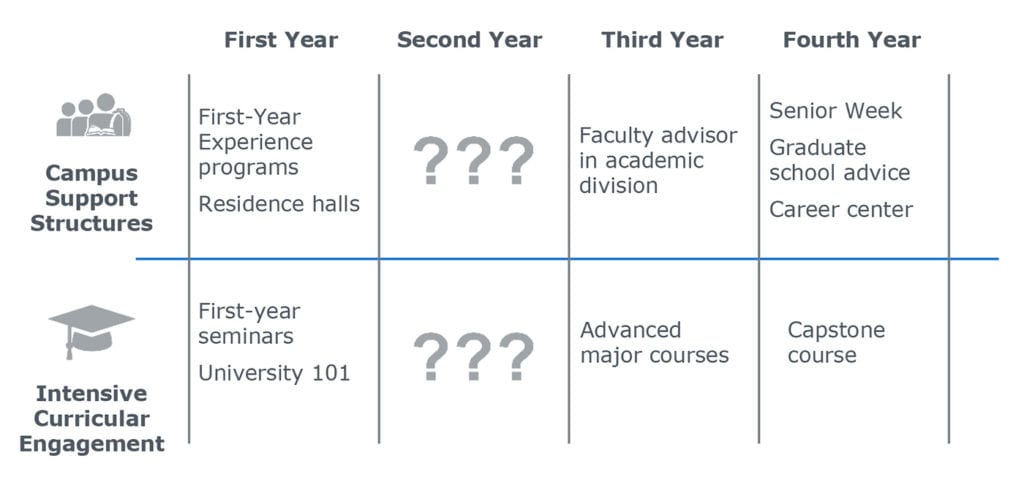Four Components of Effective Sophomore Retention Efforts
What comes after the first-year experience?
Academic leaders have devoted significant resources—enhanced first-year experience programs, new advising centers, living-learning communities, small-group seminars, and dedicated first-year events—to provide first-year students with the support and skills they need to adjust to university life.
Infographic: Understanding Students in the ‘Murky Middle’
However, when the first year ends, students suddenly lose the structured support network that provided academic and career advice, close connections with faculty, friendships and social connections, and a sense of identity. Sophomores are less likely to live on campus than first-year students. They are also less likely to be required to meet with their academic advisors.
The end of the first year does not necessarily end a student’s struggle to transition to university life; problems such as homesickness or the development of effective study skills can persist. Students still need support to be successful at the institution in their second year, and a significant portion of attrition happens during this time.
The sophomore gap

Sophomores are transitioning in their academic careers from the structured curriculum of first-year general education requirements into increasingly independent course and major selection. Over the next two years, their academic division will become the center of their life on campus. However, many sophomores do not have a clear entry point to upper-division coursework or faculty to create the mentorship relationships that promote long-term success. They may also not have access to smaller, seminar-format classrooms where they have individualized faculty attention and a closer cohort of students to help them form social connections.
Institutions should account for both the narrowing support structures offered to students after the first year and the growing need for engagement with a student’s planned major. Sophomores are more likely to persist if they declare a major by the end of the second year and have a branded sophomore identity, timely financial support, and targeted faculty engagement opportunities.

Components of effective retention efforts
1. Timely financial support
While first-year students receive financial aid assistance from high school admissions counselors, sophomores must be more independent in maintaining and renewing aid, which can be intimidating. During the first year, students may lose limited, one-year scholarships, or they may find that grants cover tuition but not the unexpected costs of attending college. Many of our members report that financial concerns are among the most common reasons why students drop out during the sophomore year.
Institutions should provide proactive attention to sophomores who struggle financially to mitigate attrition during the second year. Students may not be aware of work-study or other financial opportunities on campus, and may have ignored the information if they did not need it previously.
Download Our Research Brief on Sophomore Retention
2. Branded sophomore identity
First-year students benefit from consistent class-specific programming such as orientation and first-year seminars, especially as more institutions focus on first-year retention as a success metric. As juniors and seniors, students can more clearly associate with their major or special events such as graduation or senior week. The sophomore year lacks a specific identity that promotes on-campus engagement.
Research shows that students are more likely to return in their junior year if they are socially integrated into campus and take part in co-curricular activities. Institutions can market opportunities like career development, social events, residential housing, and community service directly to sophomores. Targeting sophomore students with these opportunities creates continuity with the structure these students experienced in their first year and offers specific engagement opportunities for sophomores. Many institutions are already offering co-curricular programs open to students in all years, so it is often only a matter of rethinking how to market these programs specifically to sophomores.
3. Targeted faculty engagement opportunities
Commitment to an academic major and meaningful interaction with faculty and staff are both significant predictors of academic success in the sophomore year and key factors influencing retention. Through targeted opportunities for interaction, faculty and staff can familiarize sophomores with their future programs of study, help students find co-curricular and career opportunities, and motivate them to succeed.
Research shows that personal connections with faculty are an important factor in year-to-year retention and in quality of life after graduation. Targeted engagement opportunities for sophomores help students feel more comfortable reaching out and making those connections as they move into a major.
Students benefit from the ability to hear personal stories about faculty’s academic and career paths; examples of how they learned from hardship, failure, or uncertainty; and the positive aspects of conducting academic or professional work in their program of study. Furthermore, small class sizes allow sophomores to benefit from a close-knit cohort of classmates and the individualized attention of a faculty instructor.
4. Best-fit major declaration
Second-year major declaration helps ensure students stay on track to graduate and select appropriate prerequisite requirements and sequenced courses. Advisors should proactively reach out to sophomores who have not declared a major or were not admitted to a selective major program and work closely on degree mapping and interest inventories. Ideally, students will be prepared to remain in the majors that they declare in their sophomore year.
Learn more about second-year retention efforts
As students progress into the second year from the more structured environment of the first, administrators can support them through targeted curricular and co-curricular programming, proactive financial aid, and academic advising focused on long-term planning. These efforts can reduce second-year attrition and help students build the stronger connections with faculty, peers, and programs of study, and create momentum toward second-year major declaration. By the end of their sophomore year, students will enter the upper division fully prepared and ready to continue their path to graduation.
Our research brief Encouraging Sophomore Success outlines these four components in more detail and includes examples and strategies for each.
This resource requires EAB partnership access to view.
Access the research report
Learn how you can get access to this resource as well as hands-on support from our experts through Strategic Advisory Services.
Learn More